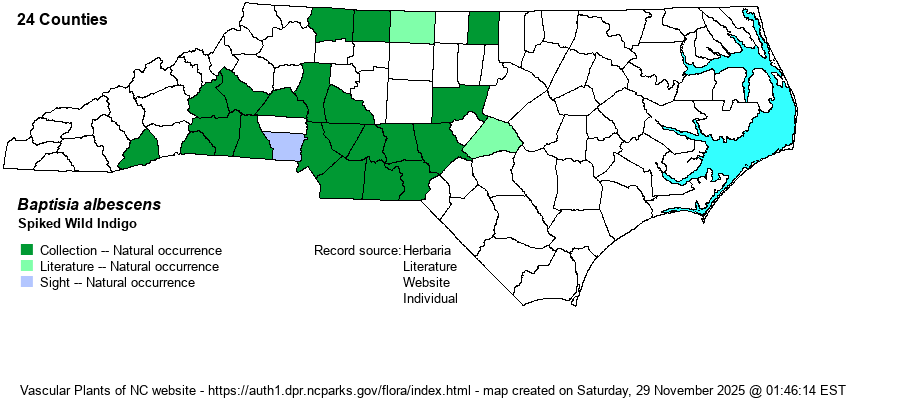| Author | Small | |
| Distribution | This species, often confused with B. alba owing to name changes in the past several decades (see Taxonomic Comments), is found over all of the southern Piedmont, but it is of spotty occurrence in the northern half and is absent in the extreme northeastern corner of the province. Ranges west barely into the southern mountains. Apparently absent in the Coastal Plain.
This is a Southern species ranging north to southeastern VA and central TN, south to northern FL and Al. | |
| Abundance | Uncommon in the southeastern Piedmont, west to Iredell and Mecklenburg counties, and rare to uncommon in the southwestern Piedmont. Very rare in the northern Piedmont and southern mountains. This species was formerly tracked by the NCNHP as Significantly Rare, but has been downgraded to a Watch List status now. | |
| Habitat | The habitats for this species and the similar B. alba are essentially the same -- both occur along mostly dry to slightly moist wooded borders and roadsides, occasionally into open woods. There seems to be no affinity to high pH soils for either species. | |
| Phenology | Blooms from May into July, and fruits from June into October. | |
| Identification | This species and B. alba are quite similar is many respects, other than the capsules. Each is a bushy-looking, glabrous, and somewhat glaucous blue-green herbaceous plant, growing to 2-3 feet tall. The alternate leaves are trifoliate, with each of the 3 leaflets being about 1.5 inches long and 1/2-inch wide. The flowers are in terminal white-flowered racemes, often many per plant, with each raceme being about 6 inches long and about 1 inch wide. Each flower is about 3/5-inch long. In fruit, these two species can easily be separated, as this species has light brown, cylindrical, and erect pods, each only about 1/2-inch wide. The similar B. alba has larger pods that are black, rounded, and drooping. In general, when in leaf or flower, B. albescens is a slightly smaller plant in most respects (such as flower size and leaflet size), but unless you are very familiar with both species, you will have to wait until capsules are present to make the identification. To see this or the other species, drive back roads in the southern Piedmont in the latter part of May into June, and look for the conspicuous spires of flowers or the spires of capsules. This species is the more numerous of the two and is likely the only one in the northern Piedmont and in the Piedmont foothills. | |
| Taxonomic Comments | The range has been confused with B. alba, especially as that species was formerly named as B. pendula, and this species was formerly known as B. alba. Thus, specimens labeled as "Baptisia alba" in many or most herbaria cannot be comfortably placed by the website authors into the correct species as currently named. The range map below is thus based mostly on 1) records as shown for the original B. alba in RAB (1968), and 2) counties recorded in the NCNHP database.
| |
| Other Common Name(s) | Thin-pod White Wild Indigo is the name used in Weakley (2018), to clearly separate this species from the currently named B. alba, which he names as Thick-pod White Wild Indigo. Both species have white flowers, and as most references attach the name of White Wild Indigo to Baptisia alba, and Spiked Wild Indigo to this one, the website editors choose to go with Spiked Wild Indigo, as well. | |
| State Rank | S3 | |
| Global Rank | G4 | |
| State Status | W1 | |
| US Status | | |
| USACE-agcp | | |
| USACE-emp | | |

